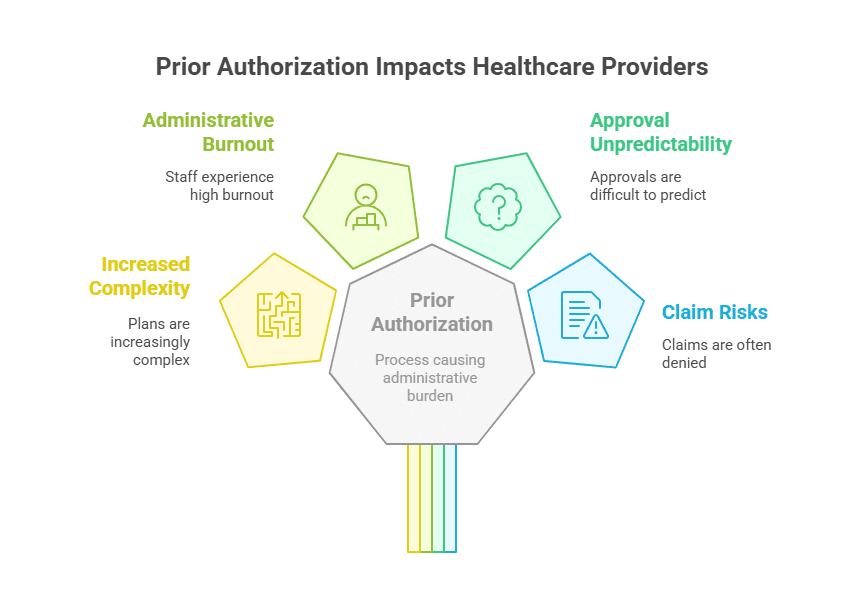On-Demand Outsourcing BPO Services for Healthcare Providers With 24/7 Coverage!
Save up to 70% on staffing costs!
Browse Specialty Staffing ServicesHow Prior Authorization Support Reduces Delays and Denials in Healthcare?

At a busy outpatient clinic, a patient needed a routine medication. The provider wrote the prescription, confident it would be filled the same day. But when the patient returned a week later, they still hadn’t received a single dose. “The pharmacy said my insurance won’t cover it without prior auth,” the patient explained. What should have been a straightforward decision turned into a frustrating administrative loop calls, forms, and endless back-and-forth on portals. Clinical staff spent hours collecting documentation and following up with the payer, only to be told: “More information needed.” It wasn’t an exception. It was just another day in healthcare.
Prior Authorization: A System Designed to Save, Now Slowing Care
Prior authorization (PA) was designed to ensure treatments are appropriate and cost-effective. But the process has become increasingly complex—adding significant delays, draining staff time, and contributing to provider burnout.
PA is now required for:
-
Prescription medications
-
Imaging services
-
Outpatient procedures
-
Medical equipment
-
Therapy visits and more
Each insurance plan has its own rules, forms, and timelines—few of which are standardized or transparent.
Why Prior Authorization Still Hurts Providers in 2025?
Despite digital health tools and process improvements, PA remains one of the most time-consuming and costly workflows in a clinical setting.
-
Increased plan complexity: Constantly changing payer rules require continuous monitoring.
-
Administrative burnout: Time spent on paperwork replaces time spent with patients.
-
Approval unpredictability: Similar cases often receive different outcomes from different insurers.
-
Claim risk: Missed or mishandled PA leads to denials and delayed reimbursements.

The Data Speaks for Itself
-
94% of providers report that PA delays care (AMA, 2024)
-
25% of requests are abandoned due to administrative burden
-
60% say prior auth requirements are increasing
-
Thousands of dollars are lost monthly from missed or denied authorizations
The Real-World Impact
🔹 A test was denied because the insurer wanted an alternative step first even though the patient clearly qualified for the original request.
🔹 A clinic lost several follow-up visits in a single month due to delayed medication approvals. The patient stopped showing up. The care team lost time and revenue.
These stories play out in clinics every day across the country.
Key Trends Shaping Prior Authorization in 2025
-
Automation tools are growing but are still limited in adoption across systems.
-
AI prediction models now assist in identifying likely PA requirements, but integration remains slow.
-
Insurer collaboration is increasing, offering faster approvals in narrow use cases.
-
Outsourced PA teams are helping providers offload the burden without expanding internal staff.
How Staffingly Solves the Prior Auth Problem?
Staffingly’s virtual PA teams are trained to manage the entire workflow efficiently and accurately. We provide:
Full-Service Support
We handle everything from initial submission to final approval including appeals and documentation tracking.
Payer-Specific Knowledge
We stay on top of constantly changing insurer rules, avoiding common rejection triggers and missing information.
Seamless Integration
No disruption to your existing systems. Our team adapts to your workflow whether through EMR, fax, or payer portals.
Continuous Monitoring
We follow up on every request until a decision is made keeping your team informed and your patients on track.
Faster Turnaround
Staffingly reduces average PA processing time by up to 65%, helping patients begin treatment sooner and reducing administrative stress.
Why Clinics Are Shifting to Virtual PA Support?
A clinic reduced denials by nearly 40% after offloading PA tasks to a virtual team.
Treatment start times improved significantly due to faster approval cycles.
Clinical staff were freed up to focus on patient care, not insurance paperwork.
What Did We Learn?
Every prior authorization request is a potential barrier between patients and the care they need. When left unmanaged, it not only drains resources but also delays treatment and erodes staff morale. However, there’s a better solution. By outsourcing prior authorization to a trained virtual team, clinics can reduce denials, accelerate decisions, and give their staff more time to focus on patient care. With Staffingly, healthcare practices no longer have to choose between efficiency and compassion. Let us handle the administrative burden so your team can stay focused on what truly matters.
What People Are Asking?
Q: What is prior authorization in healthcare?
A: It’s an insurance requirement to approve certain treatments before they’re provided.
Q: Why does prior authorization cause delays?
A: It involves manual paperwork, insurer follow-ups, and unclear requirements.
Q: How does prior authorization impact clinics?
A: It drains staff time, delays patient care, and increases claim denials.
Q: Can automation fully solve prior auth challenges?
A: Not yet—many systems lack integration with payers and require manual intervention.
Q: What’s the benefit of outsourcing prior authorization?
A: It reduces denials, speeds up approvals, and frees up clinical staff.
Q: How does Staffingly support prior authorization?
A: Staffingly’s virtual team manages submissions, documents, and payer follow-ups end to end.
Disclaimer
For informational purposes only; not applicable to specific situations.
For tailored support and professional services,
Please contact Staffingly, Inc. at (800) 489-5877
Email : support@staffingly.com.
About This Blog : This Blog is brought to you by Staffingly, Inc., a trusted name in healthcare outsourcing. The team of skilled healthcare specialists and content creators is dedicated to improving the quality and efficiency of healthcare services. The team passionate about sharing knowledge through insightful articles, blogs, and other educational resources.
 Book a Demo to Build Your Team Today!
Book a Demo to Build Your Team Today!

 Read Case Studies
Read Case Studies 



 Virtual Medical Assistants
Virtual Medical Assistants



